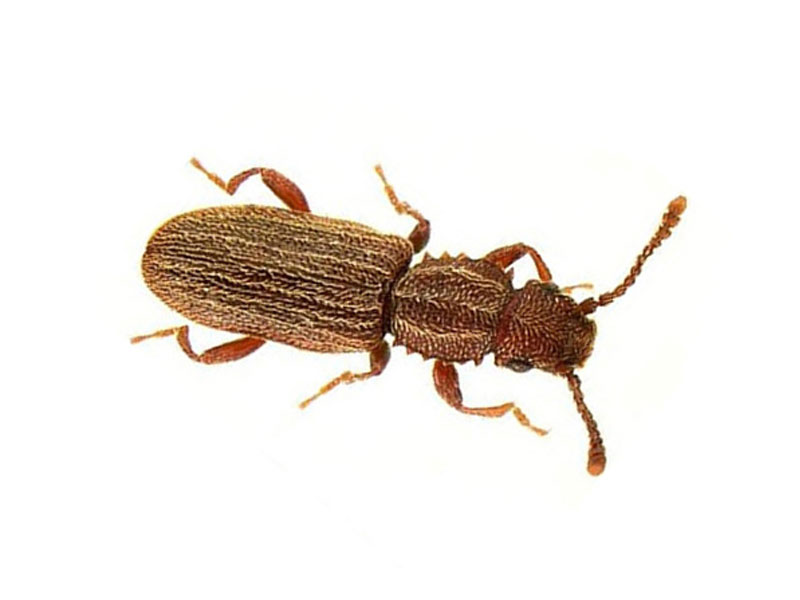Saw toothed and Merchant grain beetles infestation

The Saw Toothed (Oryzaephilus Surinamensis) and Merchant (Oryzaephilus Mercator) grain beetles are very similar in appearance. Their similar appearance and the fact that both pests are rather small is making it extremely difficult even for specialists to distinguish between the two of them.
The adult Merchant beetles are able to simply fly into your home or business premises whenever they are looking for new food sources. Another way of introduction is through bringing or delivering a pack of contaminated grain product. The beetles will then spread into the property, getting access to food sources that are available at your kitchen or commercial storage area. They prefer and tend to feed on food sources with higher oil content (e.g. copra or nuts). Unlike the Merchant beetles, the adult form of the Saw Toothed beetle cannot fly and prefer less greasy grain products (e.g. beans and peas).
Saw Toothed and Merchant grain beetles infestation are common to affect storage of products, such as cornmeal and cornstarch, cereals, bran, flour, rolled oats, dried fruit, pasta, spices, dried meat, bread, herbs, chocolate, drugs, pet food, etc… The beetles can chew their way through cardboard, foil and paper packages, so that they can get to their food source.
Once established, a Saw Toothed or Merchant grain beetle infestation spreads rather quickly. The beetles spread around the foodstuff and food debris in the corners of cupboards or cracks and crevices in shelves of commercial warehouses or storage facilities. The larvae and the adult forms of both beetles feed externally, usually on fine grain particles and not on whole grains. The beetles also have running legs (similar to the ones of the cockroaches) that helps them crawl onto different surfaces, finding easier access to their food source.
Saw toothed and Merchant grain beetles control

When it comes to the control and treatment of the Saw Toothed and the Merchant grain beetles, the general tips for prevention and removal of stored product insects are good sanitisation and regular inspection of the stored products. Trying to reduce the amount of bulk products stored at home or excess of food storage and debris in the warehouse is another way to decrease the risks of introduction. Replacing the original product packaging with glass jars or plastic containers may also help you keep the stored product beetles away from their food source.
Thorough checks of deliveries is another effective approach in detecting and preventing an infestation. If the your residential property or business premises are already infested, then careful disposal of the infested products, together with thorough sanitisation of all shelves and storage spaces is highly recommended before having a treatment done. For more difficult or severe infestations fumigation and spray with professional-use-only insecticide is a very effective approach. Our British Pest Control Association (BPCA) trained pest technicians are able to carry out safe and effective treatment, fully compliant with the UK pest legislation, delivering a long term solution to the problem. In some cases heat treatment with hot air may be a good option, as well as targeted heat with dry steam, sanitising all surfaces and eradicating all life stages of the beetles and other pest insects.
For industrial properties and businesses handling grains and stored products in general it is also vital to keep high level of hygiene in the premises and clean the silos or industrial containers really well before replacing with new products. The equipment should be checked on a regular basis as well as it may have food debris left inside that might trigger the pests. If an infestation is already present, fumigation or surface spray with specific insecticide is highly recommended. That will help eradicating all life stages of the grain beetles, preserving the product, so that it could be used afterwards.
About Saw toothed and Merchant grain beetles
The Saw Toothed and the Merchant grain beetles may seem very similar at first but they have their differences if looking at them carefully. Both beetles have 6 saw-shaped projections on both sides of their thoraxes. The Saw Toothed beetle has longer head behind its eyes, while the head of the Merchant beetle is shorter. The total length of the two beetles is around 2.5 mm – 3 mm. Their larval forms are pale yellow to brown in colour.
They also have similar lifespans – the two beetles lay single eggs or small batches of eggs and the adult forms live for about 6 to 10 months. Very rarely some might survive for slightly over 3 years. The life cycle of the Saw Toothed beetles can be completed for a period of 51 days from the egg through the larvae and the pupa to the adult form in the end. In more favourable temperatures the cycle can be completed within 27 to 35 days. The Merchant beetle have a life cycle of 35 days and may have 6 to 7 generations. These beetles do not have tolerance for low temperatures.
